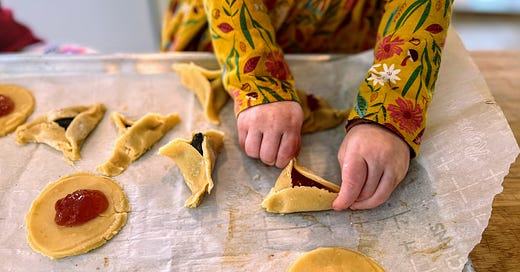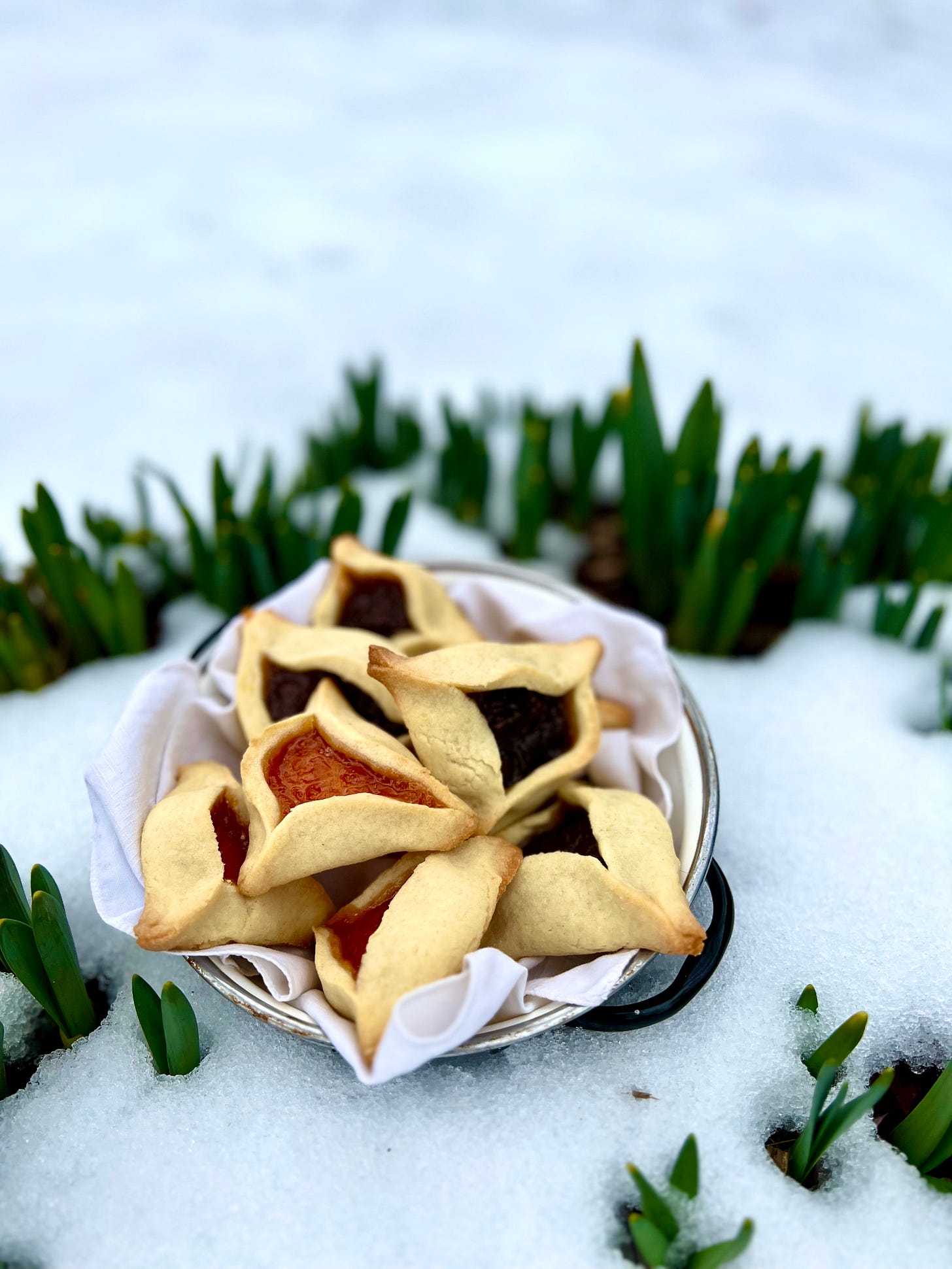This Jewish Pastry Is Not What You Think
Sneak peak recipe (and its surprising origins) from my new book
Hello dear friends!
One of my favorite Jewish holidays, Purim, is around the corner.
And that means one thing in our family: hamentaschen (recipe below).

My father was raised as an Orthodox Jew, which is why he says I was not. While my parents dabbled in sending us to Hebrew school, the only consistent part of my Jewish upbringing was matzah ball soup.
However, being married to a Jew (who was raised Jewish) has allowed me to learn about that part of my heritage alongside my children.
Not unexpectedly, my primary interest in any Jewish holiday was the food.
I always drew the kids’ attention to the seasonal ingredients featured in our holiday dishes. By doing this, I eventually noticed that the biblical stories - and the meals paired with them - nearly always reflected the time of year and seasonally available ingredients. Classic examples include spring lamb for Easter and Passover, and autumn apples and honey for Rosh Hashanah.
It turns out, the stories and meals themselves are vessels for preserving much older traditions of honoring the earth.
This is a recurring theme for many of the recipes in my new book.
Hamentaschen, the iconic dessert served at Purim, are no exception. In this case, the ingredients and the shape of the food are seasonally symbolic.
Here is the headnote for hamentaschen from Seasonal Family Almanac, aptly renamed Poppy Seed Pockets:
For years Emma made these pastries to coincide with the Jewish festival of Purim, but it turns out they’re more closely tied to the murmurings of spring than they are to the Bible. The modern name for these pastries, hamentaschen, translates to “Haman’s ears,” and comes from a villain that was set on persecuting the Jews. Queen Esther, who was informed of Haman’s plot, risked her life to save the Jewish people by reporting the plot to the king, yet Haman got the cookie credit. Still, it’s believed that Queen Esther represented Ishtar, the Babylonian goddess of sex, love, and fertility, who brought protection and health to the home. Before Israel became a monotheistic nation, women baked small cakes in her honor in the early spring, filling vulva-shaped taschen (pockets) with mohn (poppy) seed paste to represent new life. This seasonal connection gives these treats more meaning!
Vulva shaped desserts filled with life-giving seeds = fertility = spring. Mind blown!
Arielle Kaplan provides one of my favorite overviews of the pastries’ origins, along with Susan Schnur’s article on the hamantasch herstory.
So… as you devour these treats, consider leaving a poppy pocket at the base of a favorite tree or on your windowsill as an offering to Ishtar ;-). If she doesn’t scoop it up, it will be welcomed by a hungry creature who braved the winter.
Please consider sharing this with anyone you think might gobble it up!
Sending love from snow drifts and daffodil shoots,
Emma
Poppy Seed Pockets
Level: Medium
Yield: About 22 cookies
NOTES: Grind the poppy seeds into a coarse flour in a spice or coffee grinder, a high-powered blender, or a mortar and pestle. If children don’t like the poppy seed filling or you want to save time, replace it with a fruit spread or jam.
POPPY SEED PASTE
2 Medjool dates
1⁄2 cup poppy seeds, ground
1⁄4 cup honey
2 Tbsp milk of choice
2 Tbsp unsalted butter, melted
DOUGH
3⁄4 cup unsalted butter, at room temperature
2/3 cup granulated sugar
1 large egg
1⁄2 tsp vanilla extract
Zest of 1 lemon
1⁄4 tsp fine sea salt
2 1⁄4 cups all-purpose flour
EGG WASH
1 large egg (optional)
To make the poppy seed paste: Pour hot water over the dates and let rest for 5 minutes. Drain the dates and transfer to a food processor or high-powered blender. Add the ground poppy seeds, honey, milk, and melted butter. Whiz until combined into a sticky paste. Transfer the paste to a jar or container, seal, and refrigerate until ready to use or for up to 1 week.
To prepare the dough: In a stand mixer fitted with the paddle attachment, or using a bowl and an electric mixer, combine the butter and sugar and beat on medium-high for 1 to 2 minutes, or until the mixture moves past the crumbly state and comes together into a pillowy form. Scrape down the sides of the bowl. Add the egg, vanilla, lemon zest, and salt and beat on medium until smooth and creamy. Add the flour and beat on low until moist crumbles form. Using your hands, bring the flour mixture together in the bowl and gently knead just until it forms a smooth dough.
Separate the dough into two balls and flatten them into disks. If baking later, wrap the dough in beeswax wrapping or plastic wrap and store in the refrigerator for up to 3 days. When ready to bake, remove the dough from the refrigerator and let it soften slightly. If baking right away, do not refrigerate.
When ready to bake, preheat the oven to 350°F and position two racks in the middle. Line two large baking sheets with parchment paper.
Dust a clean surface and a rolling pin with flour. Working with one disk at a time—keep the remaining dough covered with a damp tea towel—roll out the dough until 1⁄8 inch thick, dusting with more flour as needed to prevent sticking.
Use a 3-inch round cookie cutter or jar lid to cut as many circles as you can from the dough, and use a bench scraper or spatula to carefully transfer the circles to the prepared baking sheets. Collect the scraps of dough in a ball, flatten into a disk, and roll and cut again. Repeat with the remaining dough.
Add 1 1⁄2 tsp (not more!) of the poppy seed paste to each circle. Bring two sides together to form a pointed cone and pinch the corners together to hold. Fold over the remaining side, leaving a quarter-size window in the middle to reveal the filling, and pinch the corners to hold. You will have a triangular shaped pastry.
For a beautiful, golden sheen, whisk the remaining egg and brush it over the dough. Bake for 12 to 20 minutes, or until the bottoms are lightly browned. Transfer to a wire rack and let cool before serving.
Store leftovers in an airtight container at room temperature for up to 3 days or in the refrigerator for up to 7 days.
More details and sneak peek recipes from my new book at seasonalfamilyalmanac.com







Yum! I could also see a goat chevre spinach filling being really delicious. So many options!
These look SO yummy! Love the new logo Emma!